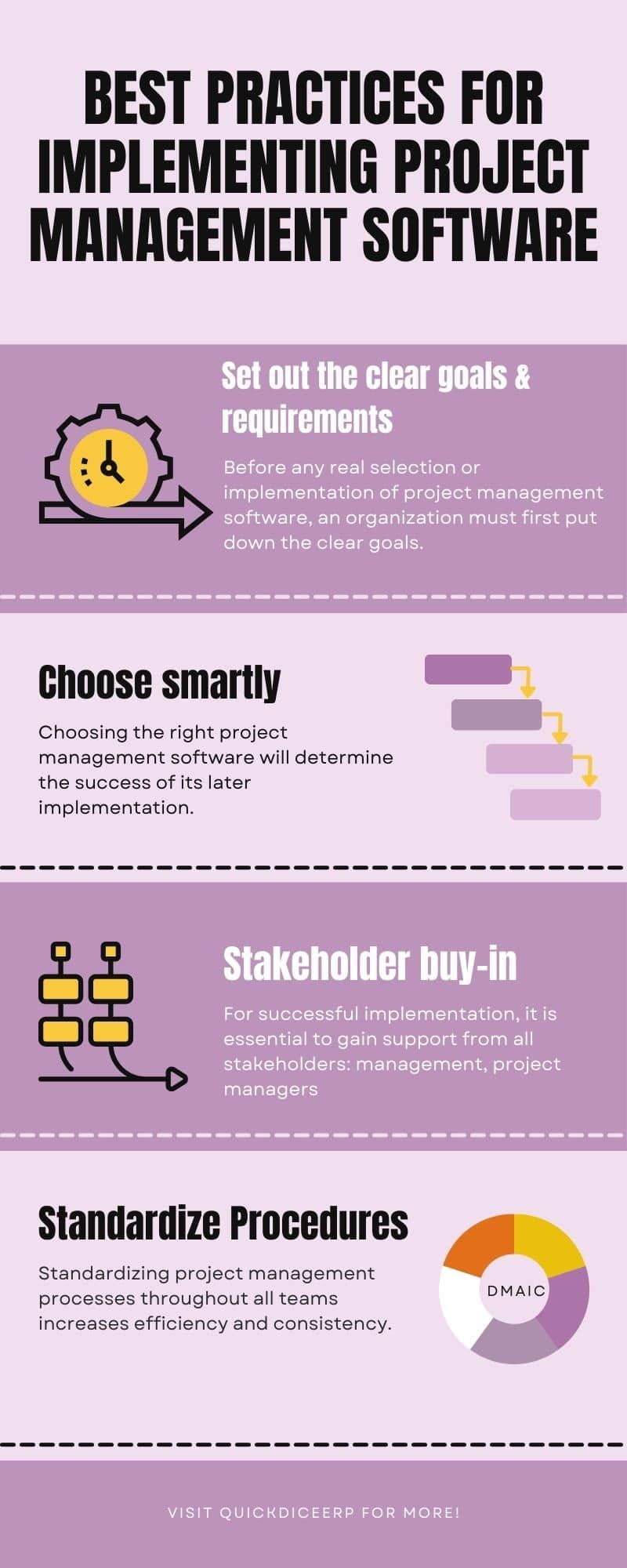Best Practices for Implementing Project Management Software
 Aya Basha
24 Mar, 2025
11 mins read
40
Aya Basha
24 Mar, 2025
11 mins read
40

Today in fast business organizations rely on project management software to not only improve the workflow but also make collaboration among teams effective and ensure the timely completion of projects. Small or big, the suitable software can enhance productivity and efficiency greatly. Thus, the concern lies with improper implementation of that leads to low usage or even workflow disruption. Businesses must adopt the best practice regarding such software to ensure seamless transition and ease of integration with the current process to all these benefits.
Choosing the right Project Management Software’s requires careful planning, user training, and ongoing support. Without a strategic approach, teams may find it difficult to adapt, leading to poor acceptance. Factors such as ease of use, scalability, and compatibility with other tools must be addressed prior to implementation. This article explains the best-practice requirements that a business would undertake to integrate project management solutions successfully by presenting a smooth transition improving overall outcome of the project execution.

Here are some of the Best Practices for Implementing Project Management Software.
1. Set out the clear goals and requirements

Before any real selection or implementation of project management software, an organization must first put down the clear goals. What are the basic needs and pain pointing the software will satisfy? Such questions could include:
- What problems does the team face in project management right now?
- What features are needed for increased productivity?
- How will the software gel with business goals?
Having clearly listed requirements ensures that the selected software does meet organizational needs and helps cut down on expensive changes later on.
2. Choose smartly

Choosing the right project management software will determine the success of its later implementation. Organizations should get options based on several criteria:
- Ease of use: High adoption rates will be found with better use interfaces.
- Scalability: Software will be ready for more clients in the future.
- Integration: Compatible with tools being used today to sustain the workflow.
- Customization: Features can be changed to meet their particular needs.
- Cost benefit: With a consideration of pricing models and ROI potentials.
- Demo versions and free trials will allow teams to kick the tires with alternative software before settling on one choice.
3. Stakeholder buy-in

For successful implementation, it is essential to gain support from all stakeholders: management, project managers, and team members. Demonstrate the software's advantages and address concerns. Involving key players in the early stages facilitates engagement and minimizes resistance to change.
4.Conditioning should Be Up to the Mark
Even the most user-friendly software requires adequate training in mentoring its effective use; organizations must afford sufficient training for its users that would comprise:
- Hands-on training tutorials: Interactive training sessions for software familiarization.
- Online resources: User manual & documentation, video demo tutorials, and FAQs.
- Continuous help and support: Help desk or customer support to solve issues.
- Training should be continuous for the team to keep aligned on any new features or best practices.
5. Standardize Procedures
Standardizing project management processes throughout all teams increases efficiency and consistency. Map the workflows, assign roles, and create guidelines for using the software that may include:
- Starting with project templates for repeatable jobs.
- Standardizing the file and task naming convention.
- Defining approval paths and access privileges.
- Standardized processes minimize confusion and facilitate collaboration.
6. Conduct a Pilot Implementation First
The phased implementation process can uncover potential impediments before full release. Begin with a small team or department to test the software's functionality and get any feedback. Look for:
- User experience and adoption.
- The challenges experienced by initial users.
- Necessary adjustments before rollout to the wider organization.
- Once the pilot is successful, the tool should gradually be opened for use across all the teams.
7. Promote Collaboration and Communication
A project management software will create a new definition of collaborative work when used rightly. Encourage teams to use communication features such as:
- Task comments/discussion threads.
- Real-time notifications and updates.
- Sharing files and managing documents.
- Potentially, the software can integrate with other tools that are currently facilitating communication (e.g., Slack, Microsoft Teams).
8. Performance Monitoring and Feedback
The software's effectiveness should be evaluated on a regular basis by monitoring key performance indicators (KPIs) such as:
- Project completion ratio.
- Task efficiency and time records.
- User engagement and adoption levels.
User feedback collection helps identify pain points and areas for improvement. Continuous updates and changes to the program make it relevant and helpful to the team.
9. Security and Compliance
Security should be the foremost consideration for implementing project management software. Organizations should ensure that such software:
- Is fully compliant with industry regulations and data protection law.
- Is encrypted efficiently and secure against unauthorized access.
- Has favorable backup and disaster recovery features.
- Conducting training for employees regarding security best practices is another way of protecting sensitive data.
10. Continuous Improvement and Adaptation
The evolution of project management software should, thus, never cease due to changing needs of an organization. Always monitor its effectiveness and keep track of new features or integration opportunities that can improve efficiencies. Keep abreast with current trends in the industry to ensure success in implementing project management procedures.
Conclusion
A software application would not suffice in agreeing on a project management software since successful implementation would involve a well-structured approach toward ensuring that there is user training, integration with the workflows, and continued evaluation. Key performance indicators such as setting clear objectives, involving key stakeholders, and offering continuous support are among best practices that improve the organization in this regard. Going along with users to realize their needs and aligning them with software capabilities reduces maximum productivity disruption disruptions.
Having an active mind and keeping an eye on the system's performance will ensure long-lasting success. As business environments shift, tools for the proper management of projects will need to be changed and improved to reflect these demands. When a good plan is set in place, businesses can enjoy all the benefits of project management software: less messy operations, more productive relationships, and successful project deliveries.
Written By:
Aya Basha



Hotels at your convenience
Now choose your stay according to your preference. From finding a place for your dream destination or a mere weekend getaway to business accommodations or brief stay, we have got you covered. Explore hotels as per your mood.


